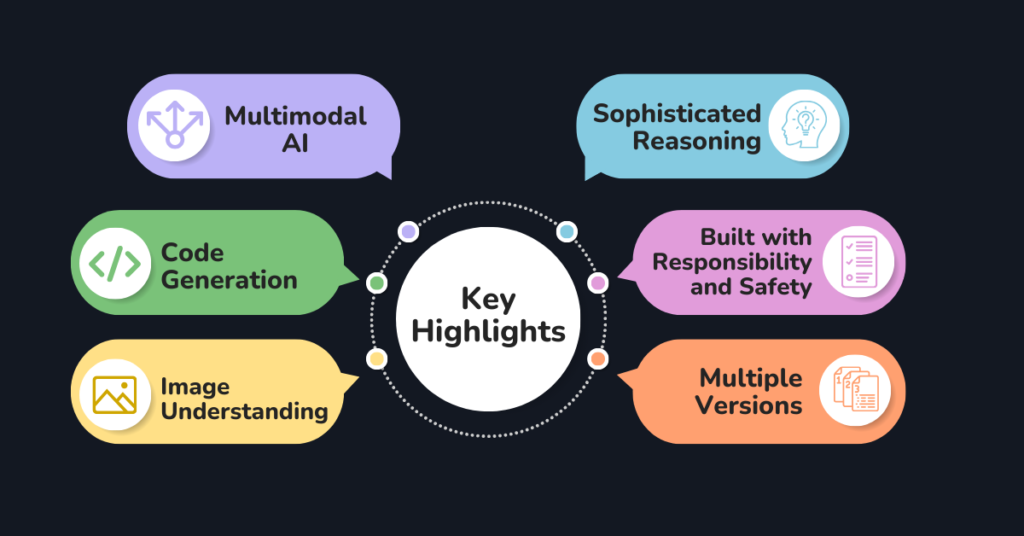Google’s Multifaceted Gemini AI Poised to Change the Game
January 30, 2024

ChatGPT, the free-to-use generative AI chatbot, was launched in 2022. In a very short time, it became a significant competitor for Google with its built-in capabilities to chat like humans.
Microsoft CEO Satya Nadella was waiting to challenge Google’s dominance in the search engine industry. And they tried to pull things back with ChatGPT-powered Bing.
Google did not want to play catch-up and wanted to show that it had not lost its edge, so they rolled out their early experiment, Bard. After months of waiting, Google’s Bard AI has come with improved features, now called Google Gemini.
What is Google Gemini?
Google’s Gemini is a large language model (LLM) and is the strategic response to ChatGPT. It comes with multimodal capabilities and provides access to Google’s extensive proprietary training data from various services. Of course, it challenges the dominance of ChatGPT in the generative AI space.
Google Gemini was developed by Google’s DeepMind and was launched on December 6, 2023. It stands as a game-changer in the field of AI and represents Google’s strategic move to counter the influence of ChatGPT, a currently dominant AI generative tool.
Research indicates the tremendous growth potential of generative AI, with analysts anticipating the market cap to reach $1.3 trillion by 2032. This highlights the significance and expected impact of technologies like Google Gemini in shaping the future of AI.
DeepMind, an artificial intelligence company that was acquired by Alphabet in 2014, has undergone a merger with Google’s Brain team to establish Google DeepMind. This integration consolidates Google’s proficiency in large language models with DeepMind’s expertise in generative models, robotics, and more, forming a unified AI research group at Google.
Key Highlights About Gemini And Its Capabilities:

1. Multimodal AI: Gemini represents a new paradigm in generative AI, capable of processing various types of data, including:
- Images
- Text
- Code
- Sounds
This approach closely mirrors the way humans process information in their brains. While most AI systems are unimodal, designed to process a single type of data, and their algorithms are tailored to that modality, Gemini breaks away with its multimodal architecture.
Gemini’s multimodal architecture, comprised of a set of neural networks, allows it to integrate and process multiple modalities, producing more than one type of output. Each type of data is handled by its own separate neural network, rendering the AI input module multimodal and composed of several unimodal neural networks.
2. Code Generation: Gemini excels in creating and comprehending high-quality code in commonly used programming languages. Leveraging artificial intelligence and machine learning, Gemini generates code based on prompts. This capability has the potential to influence software development and automation significantly.
Gemini can generate code for various development tasks and programming languages such as JavaScript, Python, Prolog, Fortran, and Verilog. Additionally, it provides human-like descriptions, going beyond mere code generation. Gemini helps in debugging code and provides explanations.
For more information, you can explore Gemini’s capabilities in AI code generation on Google Cloud: AI Code Generation.
3. Image Understanding: Gemini is a powerful tool for image and text processing via multimodal capabilities. It can generate responses based on prompts and create text descriptions from images. Gemini excels in generating stories by connecting text and images and providing captions for images.
Multimodal prompting gives Gemini various capabilities. For example, based on the prompt, it can predict what is going to come next. Here are the following areas where it can work:
- Spatial reasoning and logic
- Image sequences
- Magic tricks
- Cup shuffling
- Game creation
Do you want to see generative AI artistry? Check out this post, which covers 7 incredible Free Image Generator Tools to unlock creativity. Turn text into stunning visuals and brand-new artistic compositions.
4. Sophisticated Reasoning:
Gemini 1.0 is very good at understanding complex written and visual information. It makes it able to find knowledge hidden in lots of data.
It can read hundreds of thousands of documents and understand the information. It helps it gain insights very quickly in many fields like science and finance.
5. Built with Responsibility and Safety: AI. Gemini is based on Google’s AI Principles, and the company has always committed to being bold and responsible. Google claims to have considered potential risks at each stage of development and has done extensive testing to address issues like bias and toxicity.
They also stated that they have worked with outside experts to evaluate Gemini for blind spots. Safety is a top priority in developing this technology.
6. Multiple Versions
Gemini comes in three versions—Ultra, Pro, and Nano—each with varying capabilities and resource requirements. Ultra is the most powerful, while Nano is accessible for broader use.
- Gemini Ultra: This is the most powerful model, designed for large-scale tasks and research.
- Gemini Pro: Capable of a wide range of tasks and suitable for most users.
- Gemini Nano: A smaller model specifically designed for use in embedded systems and mobile devices.
What is so unique about Gemini AI?
Several unique features distinguish Gemini in the field of artificial intelligence. Gemini can process various information types, making it different and unique from other conventional LLMs as they focus only on text. It is outperformed in complex reasoning and understanding the relationship between various sources. It is important to remember that it is under development, and its full potential is yet to be realized. However, its unique features are pushing the AI boundaries to tackle diverse challenges.
It’s a Wrap
The distinct features of the Gemini make it not only match but also outperform human intelligence. The multimodal capabilities to understand the complex world dynamically push it far beyond its predecessors like GPT. Its potential uses range from simple productivity tasks to groundbreaking scientific discoveries.









